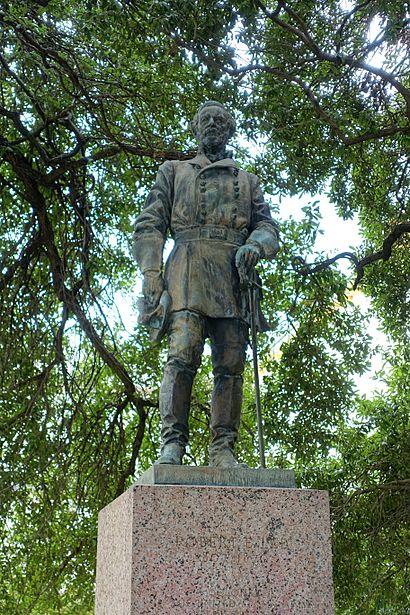Statue of Robert E. Lee (Austin, Texas) facts for kids
Quick facts for kids Statue of Robert E. Lee |
|
|---|---|

The statue in 2015
|
|
| Artist | Pompeo Coppini |
| Year | 1933 |
| Medium | Bronze sculpture |
| Subject | Robert E. Lee |
| Location | Austin, Texas, United States |
| Owner | University of Texas at Austin |
The Robert E. Lee statue was a large bronze sculpture. It showed Robert E. Lee, an American general. The artist who created it was Pompeo Coppini.
This statue was first asked for in 1919. It was meant for the Littlefield Fountain at the University of Texas at Austin. The statue stood on the university's South Mall in Austin, Texas. It was there from 1933 until it was taken down in 2017.
Contents
History of the Robert E. Lee Statue
In 1919, a man named George W. Littlefield gave money. He was a leader at the University of Texas. He wanted to build a "Memorial Gateway." This gateway would honor soldiers from the Confederate side of the Civil War.
He hired Pompeo Coppini, a sculptor from San Antonio. Coppini was asked to design this monument. It was planned to have statues of important people from Texas and the American South.
How the Statue Was Made
The memorial plan changed over time. It became the Littlefield Fountain. This fountain was built to honor university students. It also honored alumni who died in the Great War. This war is now called World War I.
In the 1920s, Coppini made several bronze statues. One was of Robert E. Lee. He also made statues of five other important figures. Mr. Littlefield chose these people. Coppini planned to place them around the fountain.
Where the Statue Was Placed
Building the memorial continued into the early 1930s. The university's architect, Paul Cret, made a new decision. He chose to place the six statues somewhere else.
They were put along the university's South Mall instead. The statues were installed in 1933. This was when the fountain complex was finished.
Why the Statue Was Removed
Over time, many people felt that statues honoring Confederate figures were not appropriate. They believed these statues represented a painful past. This included the history of slavery.
Because of these concerns, the University of Texas decided to remove the statue. It was taken down in 2017. This was part of a larger discussion across the country.

